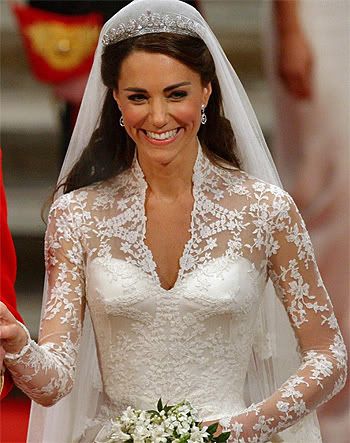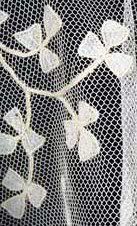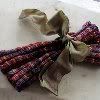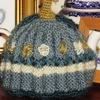I even had purchased some special Royal Wedding Tea, which I brought to work and passed around. Then we all raised our tea cups in a celebratory toast to the royal newly-weds.
But you know, none of this was in excess for me because.... well, because of the handmade Carrickmacross lace on the wedding gown!

Carrickmacross lace is named after the market town in Co Monaghan where it originated. Carrickmacross is described as a pretty market town which developed around a Castle built by the Earl of Essex in 1630. The Convent of the St. Louis Nuns now stands on the original castle site. According to the County Monaghan tourist website, Carrickmacross Lace was first established in the 1820s by Mrs Grey Porter, wife of the rector of Donaghmoyne, who brought the lace back from her honeymoon in Italy. Carrickmacross lace-makingwent into decline in the 1840s but later revived as a local art. History on the region credits the nuns for being largely responsible for the revival of lace-making skills in the region, as they taught it to their students. The Carrickmacross Lace Co-operative continues to make the fine lace and has been instrumental in keeping the tradition alive today. This lace may be purchased through their Lace Gallery, in the Market Square where they give demonstrations of this remarkable lace-making art by prior request.
Piecework Magazine, in the May/June 2011 issue, has an article (and pattern!) on Carrickmacross lace and talks about the early origins... How did they know that this would be such a feature of the Royal Wedding? What remarkable coincidence and good fortune for us, the readers!
And here is an adapted excerpt from the official Royal Wedding website:

The lace appliqué for the bodice and skirt was hand-made by the Royal School of Needlework, based at Hampton Court Palace. The lace design was hand-engineered (appliquéd) using the Carrickmacross lace-making technique, which originated in Ireland in the 1820s.
Individual flowers have been hand-cut from lace and hand-engineered onto ivory silk tulle to create a unique and organic design, which incorporates the rose, thistle, daffodil and shamrock.
Hand-cut English lace and French Chantilly lace has been used throughout the bodice and skirt, and has been used for the underskirt trim. With laces coming from different sources, much care was taken to ensure that each flower was the same colour. The whole process was overseen and put together by hand by Ms Burton and her team.
The Royal School of Needlework (RSN), based at Hampton Court Palace, assisted the Alexander McQueen team in accurately cutting out the delicate motifs from the lace fabrics and positioning the lace motifs with precision into the new design. The lace motifs were pinned, ‘framed up’ and applied with stab stitching every two to three millimetres around each lace motif. The workers washed their hands every thirty minutes to keep the lace and threads pristine, and the needles were renewed every three hours, to keep them sharp and clean.
The RSN workers included existing staff, former staff, tutors, graduates and students, with the youngest aged 19.
There are still some Carrickmacross lace-makers available, too: The Lace Gallery is one and on her website she not only offers this remarkable lace on commission, but gives the history and lace-making books.
I do have some Carrickmacross lace in my own collection - notably a wide collar from my great grandmother's wedding gown. I did a quick look for it, so I could show you but it is in some deeper place than I can readily get to right now. But it does have traditional Carrickmacross motifs of shamrock, thistle, and wild rose...


































No comments:
Post a Comment